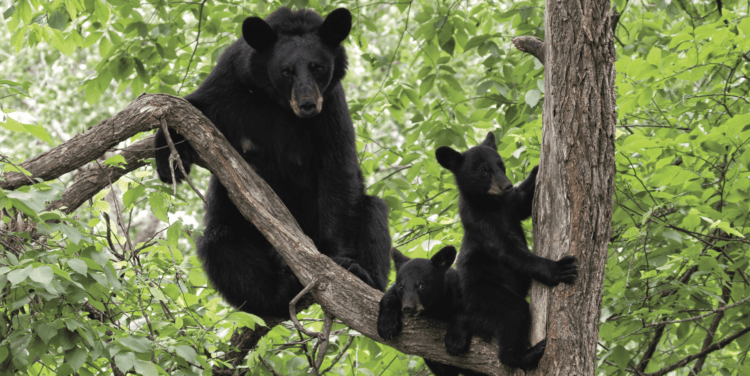Every April we begin to hear them—the accounts from our fellow Fairfield County residents. Whether overheard in line at the post office, grocery shopping, or speaking with a neighbor, invariably our paths cross with someone who has had a sighting. One neighbor saw one eating her cat food on the back deck. Another had one demolish her brand-new squirrel-proof bird feeder. Yet another saw a mom with cubs crossing the street near the end of the cul-de-sac.
If you live in Fairfield County, you have a neighbor you may have yet to meet. Spring is when our wild neighbor is on the move. The American Black bear, Ursus americanus, also known as the American bear, is no lightweight. Reaching between 6-8 feet in length and averaging weights of between 200-500 pounds, Black bears are New England’s largest terrestrial carnivore. Displaying sexual dimorphism in which males attain greater sizes than females, large males entering hibernation may reach 600 pounds in weight, with exceptionally large individuals tipping the scales at weights up to 900 pounds!
Though classified as carnivores, behaviorally, Black bears are classic omnivores, consuming everything from Prickly Pear cactus, to ants, to Moose calves! What’s more, a Black bear selects from the menu not with its eyes…but with its nose. Following their legendary sense of smell to a meal, Black bears can detect apples ripening in orchards five miles away! With the ability to outrun a Cottontail rabbit, swim as fast as a beaver, and climb as well as any raccoon, these bruins are the decathletes of the bear tribe. Found throughout our home state of Connecticut, all of New England, and most of the United States, the Black bear is one of the planet’s most adaptable and successful mammals.
Though built like other members of the world’s eight bear species, possessing a massive, fur-covered body with immensely powerful muscular limbs, sharp claws and a short tail, Black bears exhibit greater color variation than their kin. Ranging in color from solid black to black with a white chest blaze, to brown (aka Cinnamon) these bears are highly varied in appearance. With small populations such as “Blue” phase Black Bears in Southeastern Alaska, and white-furred “Spirit Bears” inhabiting South Coastal Brithish Columbia, the Black bear is a species exhibiting great diversity. Similarly, Black bears are masters of adaptation, surviving and thriving in virtually every habitat type in North America. Even their bodies reflect their status as one of nature’s great generalists. Whereas bears of the Sonoran Desert generally possess smaller body size and less bulk to dissipate body heat, bears of the Northern Hardwood forests of New Hampshire, attain much greater size and bulk.
While their physical adaptations serve them well from the Alaskan Panhandle to the Florida Keys, it is the behavioral bear which earns my full respect. Intelligent, resourceful, and responsive to opportunity, Black bears can live in close proximity to humans. In fact, they are so adaptable, this might be even closer than you think. After clawing their way back from local extinction (known as extirpation) in the Nutmeg State, Black bears have made a huge comeback. From an estimated 10-12 bears in the state’s Northwest corner in the 1980’s, to an estimated 1,000 to 1,200 bears today, these bruins have increased their population 100-fold! Where do 1,200 animals live in a state the size of Connecticut? The answer is, pretty much wherever they want. Although historically utilizing earthen dens, hollowed out root dens at the base of mature hardwoods, and caves, Black bears have settled into excellent, new accommodations quite nicely. Commonly utilizing dense brush piles, enlarged woodchuck burrows under sheds and barns, and even crawl spaces under home decks in which to hibernate for the winter, these creatures of wilderness have become creatures of suburbia!
With the maturation of Connecticut forests now exceeding 60% tree cover throughout the state, the increased nut production aids the bears and the other species such as White-tailed deer, Wild turkeys and Gray squirrels that eat the acorns, Hickory nuts, and other abundant foods of the forests. As we get reacquainted with our large neighbors, it is incumbent upon us to be good neighbors. A little knowledge goes a long way toward keeping both bears and humans safe, happy, and healthy. This knowledge comes in the form of bear awareness.
From keeping your dogs leashed when hiking, to taking down bird feeders seasonally, to knowing how to react to surprise encounters with bruins, bear awareness takes many forms, and they are all wise measures to keep people, pets, and bears safe and healthy. For more information on bear awareness, please visit Connecticut’s Beardsley Zoo’s website (www.beardsleyzoo.org) for upcoming bear lectures and other programs this spring.
In the American Black bear, we have a neighbor who can shape their habits to survive in wilderness, suburbia, or even at the edges of cities. If we can employ even a fraction of the bruin’s resourcefulness, persistence, and hallmark adaptability, we too can enjoy the kind of success that is “bearly” matched.
Jim Knox serves as the Curator of Education for Connecticut’s Beardsley Zoo. A Member of The Explorers Club, Jim enjoys sharing his passion for wildlife and conservation with audiences in Connecticut and beyond.





